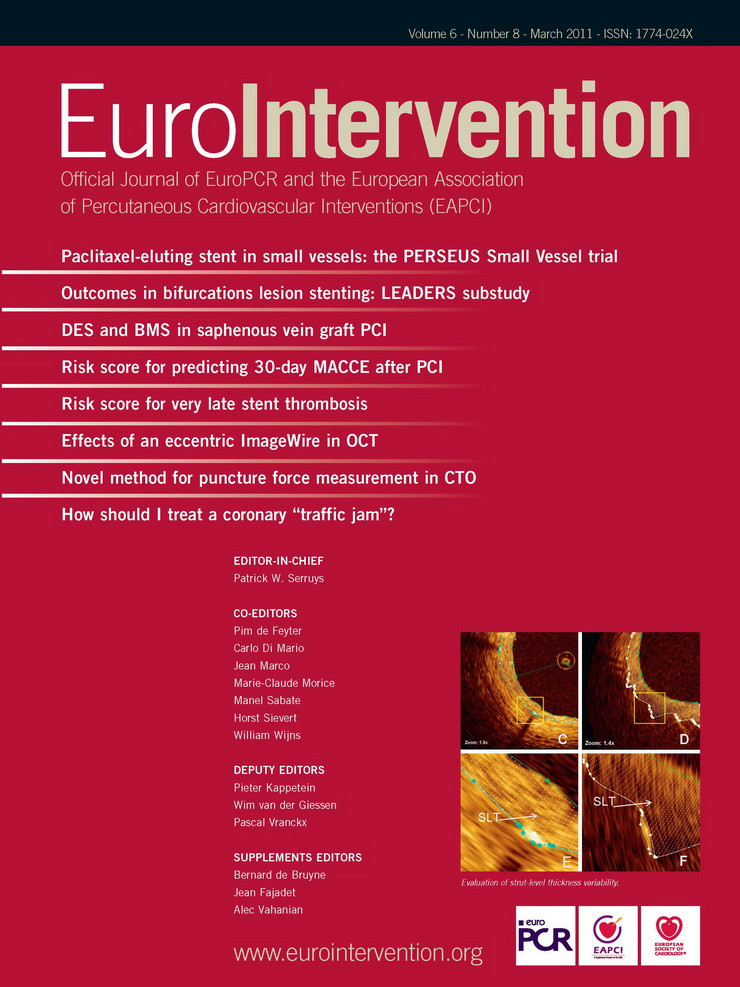In the last two decades, revascularisation has been a debatable issue that served as the basis for numerous clinical trials which compared different revascularisation methods (CABG vs. PCI) and different PCI interventions (balloon vs. BMS vs. DES). In March 2009, the results of the 12-month follow-up of the SYNTAX trial (SYNergy between percutaneous coronary intervention with TAXus and cardiac surgery)1 were published. The trial results were probably one of the reasons behind the creation of the guidelines on myocardial revascularisation by a joint Task Force of the European Society of Cardiology (ESC) and the European Association for Cardio-Thoracic Surgery (EACTS)2. The SYNTAX trial differentiated between patient groups, using the SYNTAX score that was designed to better anticipate the risks of percutaneous or surgical revascularisation, taking into account the functional impact of the coronary circulation with all its anatomic components, including the presence of bifurcations, total occlusions, thrombus, calcification and small vessels (it should be noted that the SYNTAX score is considered as a subjective assessment tool due to intra- and inter- observer variability)3. The SYNTAX 12-month follow-up concluded that the rates of major adverse cardiac or cerebrovascular events were similar among patients in the CABG group with different SYNTAX score groups, in contrast to the PCI group where the rate was significantly increased in patients with high SYNTAX scores (23.4%) as compared to those with low scores (13.6%) or intermediate scores (16.7%). Nonetheless, the CABG group patients had a higher rate of stroke in comparison to the PCI group (2.2% vs. 0.6%); the authors believed that this might have resulted from the use of highly effective dual antiplatelet therapy in the PCI group1.
The authors concluded that CABG should become the standard of care for three-vessel or left main coronary artery disease patients1. Following the SYNTAX trial, and other trials that were conducted previously, the 2010 European revascularisation guidelines recommended that a heart team should be established in each hospital, composed of an interventional cardiologist, a clinician cardiologist and a cardiac surgeon who will discuss the most appropriate revascularisation alternative for a specific patient on the morning following the patient’s diagnostic PCI. Moreover, the superiority of CABG as the best revascularisation method for high syntax score patients was emphasised2. Nevertheless, the guidelines recommended that PCI immediately following the diagnostic angiogram should be performed mainly on patients in whom PCI would be considered as a life-saving procedure2. The new era poses great challenges for both physicians and patients. Although the 21st century brought with it patient involvement in the decision-making process for the best medical solution for his disease, the new guidelines demand that we, as physicians, regain control and advise the patient as to the best medical treatment for his disease, even if it is not the easiest one. The heart team brings physicians from three different cardiac disciplines together to offer their specific measured viewpoint to the cardiac patient, and insures that «personal views» are balanced so that the best decision can be made.
As in some European countries, implementation of a heart team in Israel is a change of concept. Up until now, the cardiologist and cardiac surgeon held similar discussions, for far fewer patients; for some patients, the discussions were held during the PCI procedure. Therefore, unlike The Netherlands, implementation of the new guidelines in Israel will require major changes. Today, the majority of catheter-based interventions are performed ad hoc; immediately following the diagnostic PCI. The new guidelines recommend that the diagnostic PCI should not be followed by an intervention in most cases, but that, instead, first a heart team discussion should be followed by a discussion with the patient regarding his revascularisation options.
As in Europe, these guidelines should be adopted in Israel for many reasons, including:
1) It is best for our patients; and
2) the Israel Cardiology Society is part of European Society of Cardiology.
As in Europe, not all hospitals in Israel contain a cardiac surgery department; therefore, holding the heart team discussion the next morning will require visual and audio solutions between institutes.
As with any change, especially such a drastic one, this change should be implemented in a step-wise manner and with continuous discussions between the parties involved and guided by the Israel Cardiology Society and the Israeli Cardio-Thoracic Society.

